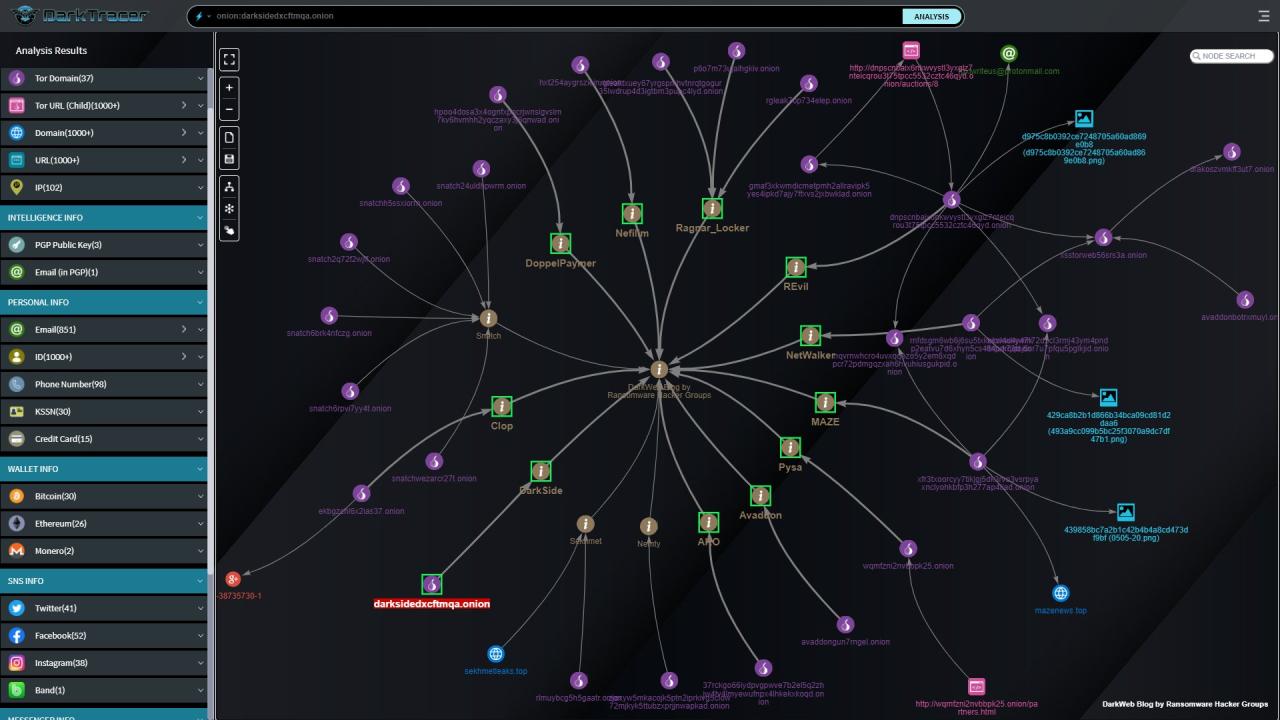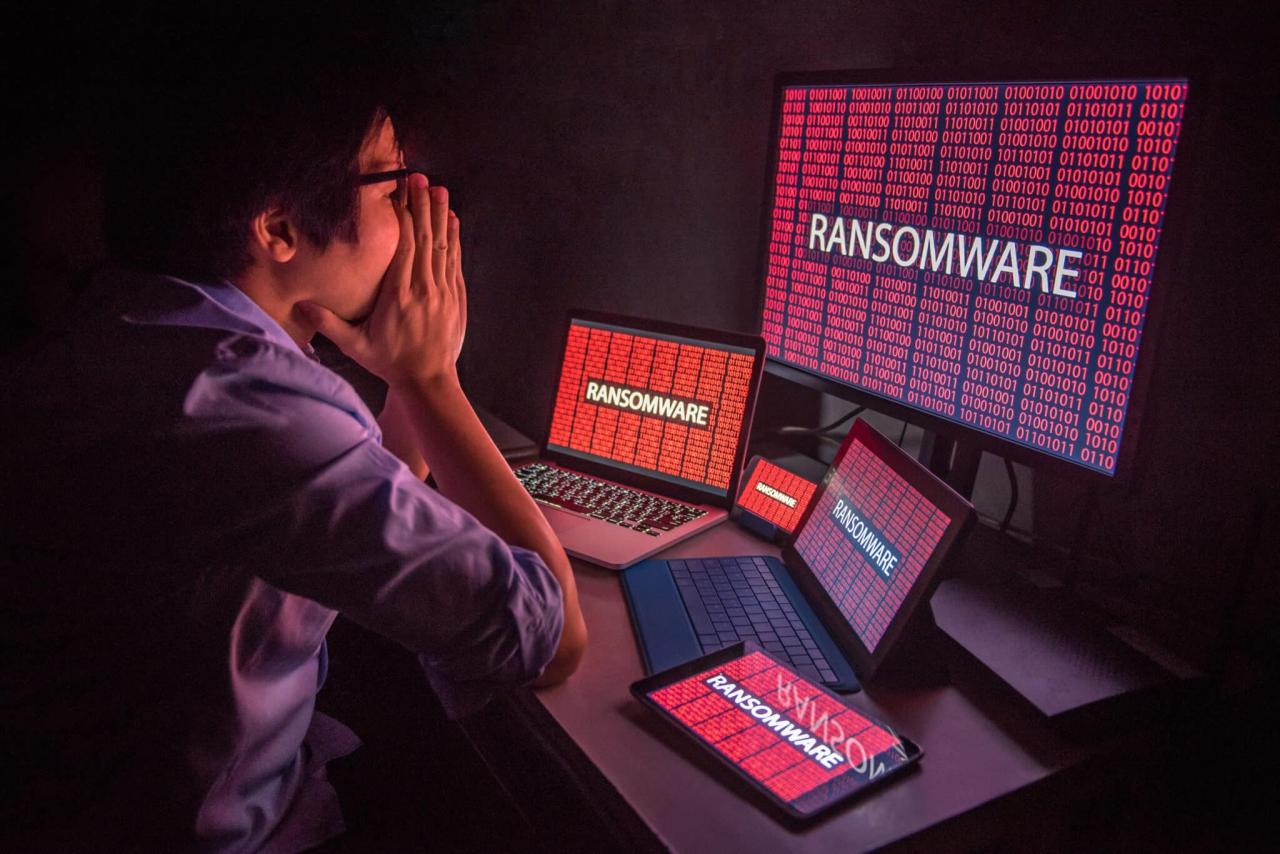
Ransomware Gangs Doxing Victims Families
Ransomware gangs doxing family members of victims is a terrifying new escalation in cybercrime. It’s no longer just about encrypting files; these criminals are now weaponizing the personal lives of their targets, using the threat of public exposure to force payment. This tactic exploits the deepest vulnerabilities, leveraging fear and emotional distress to achieve their malicious aims. The impact goes far beyond financial loss; it’s a devastating attack on families, leaving lasting psychological scars.
We’ll delve into the methods used by these gangs, the devastating psychological consequences for victims and their families, and the legal and ethical implications of this horrific practice. We’ll also explore preventative measures and the crucial role of law enforcement and cybersecurity in combating this evolving threat. This isn’t just a tech issue; it’s a deeply human one.
The Tactics of Doxing in Ransomware Attacks
Ransomware gangs are increasingly employing doxing—the public release of private information—as a tactic to pressure victims into paying ransoms. This goes beyond simply encrypting data; it targets the victims’ personal lives, creating significant emotional distress and increasing the likelihood of payment. The methods used are sophisticated and often leverage readily available information combined with social engineering techniques.Ransomware gangs utilize various methods to gather personal information about victims and their families.
Methods of Obtaining Personal Information
Ransomware gangs employ a multi-pronged approach to obtain information. They often start with publicly available data, scouring social media platforms like Facebook, LinkedIn, and Twitter for details about the victim, their family, and their associates. This can include addresses, phone numbers, email addresses, employment details, and even photographs. They might also use data broker websites which aggregate and sell personal information.
It’s horrifying how ransomware gangs are escalating their tactics, now doxing the families of victims. This kind of personal attack highlights the urgent need for robust security solutions, and I’ve been thinking a lot about how advancements like those discussed in this article on domino app dev, the low code and pro code future , could help organizations build more resilient systems.
Ultimately, stronger security infrastructure is crucial to protect not only businesses but also the innocent families caught in the crossfire of these cyberattacks.
Furthermore, sophisticated attacks might involve exploiting vulnerabilities in poorly secured systems to directly access personal databases containing sensitive information. Finally, social engineering techniques like phishing emails or calls can be used to trick victims or their contacts into revealing information.
Types of Information Targeted
The information targeted is designed to maximize pressure on the victim. Addresses are used for physical intimidation, either through direct threats or the implication of harm to property. Phone numbers enable harassment through calls and text messages. Social media profiles provide insights into family members, allowing the attackers to tailor their threats and make them more believable. Employment details are used to threaten the victim’s career and reputation.
The goal is to create a comprehensive profile of the victim and their family to exploit their vulnerabilities.
Using Doxed Information to Pressure Victims
Once the information is gathered, it is used to leverage fear and pressure the victim into paying the ransom. This can involve threatening to release the doxed information publicly, to harass family members, or even to physically harm them. The threat of reputational damage, job loss, or family disruption can be incredibly effective in persuading victims to pay, even if they are aware of the illegality of paying ransoms.
The emotional toll is significant, and the attackers often exploit this vulnerability to their advantage.
Examples of Doxing in Ransomware Attacks
While specific details of many ransomware attacks remain undisclosed due to victims’ fears of further reprisal, several cases have highlighted the use of doxing. It’s important to note that attribution in cybercrime is challenging, and definitively linking specific doxing incidents to particular ransomware groups can be difficult. However, reported cases suggest a growing trend.
| Case Name | Doxing Method | Information Leaked | Ransom Outcome |
|---|---|---|---|
| Example Case A (Hypothetical) | Social Media Scraping & Data Broker Sites | Victim’s address, family photos, children’s school, employment details | Ransom paid under duress |
| Example Case B (Hypothetical) | Exploit of vulnerable company server | Employee contact list, internal documents with family member details | Ransom not paid, data leaked publicly |
| Example Case C (Hypothetical) | Phishing campaign targeting victim’s spouse | Spouse’s banking details, home address | Ransom paid to prevent further harassment |
| Example Case D (Hypothetical) | Combination of OSINT and social engineering | Victim’s home address, family photos, work location, vehicle information | Negotiation led to a reduced ransom payment |
The Psychological Impact on Victims and Families
The doxing of family members in ransomware attacks inflicts a devastating blow far beyond the financial and data breaches. It exposes loved ones to harassment, threats, and public shaming, creating a ripple effect of trauma that can significantly impact the mental well-being of both victims and their families. This secondary victimization intensifies the already stressful situation of a ransomware attack, compounding the emotional distress and potentially leading to long-term psychological consequences.The emotional distress experienced by victims whose families are doxed is profound and multifaceted.
Fear for the safety and well-being of family members is paramount. The constant worry about potential threats, harassment, or even physical harm can lead to crippling anxiety and sleep disturbances. The public humiliation and invasion of privacy experienced by family members also inflict deep shame and embarrassment, impacting their self-esteem and social relationships. Victims may experience intense guilt for inadvertently putting their families at risk.
This guilt can be further exacerbated by feelings of helplessness and powerlessness in the face of the attackers.
Long-Term Psychological Consequences
Doxing in the context of ransomware attacks can trigger a range of long-term psychological consequences. Anxiety disorders, characterized by persistent worry, nervousness, and difficulty concentrating, are common. Depression, marked by persistent sadness, loss of interest, and feelings of hopelessness, is another significant concern. In severe cases, victims and their families may develop Post-Traumatic Stress Disorder (PTSD), experiencing flashbacks, nightmares, and intense emotional distress when reminded of the event.
The constant fear of further attacks or exposure can lead to hypervigilance and avoidance behaviors, significantly impacting daily life. For example, a family member might develop an intense fear of the internet or social media, avoiding online activities altogether.
Comparison to the Impact of the Ransomware Attack Itself
While the ransomware attack itself is undeniably traumatic – causing data loss, financial hardship, and disruption of daily life – the doxing of family members introduces a new and distinct layer of psychological harm. The ransomware attack primarily targets the victim’s personal or professional life, whereas doxing directly impacts the lives and well-being of innocent family members who were not involved in the initial cybercrime.
This expansion of the attack’s reach creates a broader and deeper sense of violation and vulnerability. The feeling of control being lost is amplified, as the victim is not only dealing with the immediate consequences of the ransomware but also with the ongoing threat to their loved ones.
Coping Strategies for Victims and Families
Coping with the emotional fallout of doxing requires a multifaceted approach. Seeking professional help from therapists specializing in trauma and cybercrime victimization is crucial. Therapy can provide a safe space to process emotions, develop coping mechanisms, and address potential long-term psychological consequences. Support groups for victims of cybercrime can offer a sense of community and shared experience, reducing feelings of isolation and shame.
Open communication within the family is vital to fostering mutual support and understanding. Developing a safety plan, including strategies for managing online presence and responding to threats, can also provide a sense of control and security. Furthermore, reporting the incident to law enforcement and working with cybersecurity professionals to mitigate further risks is essential. Taking proactive steps to protect themselves and their families can empower victims and help them regain a sense of agency in the face of adversity.
Legal and Ethical Implications

The doxing of family members by ransomware gangs presents a complex web of legal and ethical challenges, blurring the lines of traditional criminal investigations and raising serious concerns about individual rights and the efficacy of international cooperation. The actions of these groups necessitate a thorough examination of existing legal frameworks and a critical analysis of the ethical responsibilities of both the perpetrators and law enforcement agencies.
Applicable Legal Frameworks
Several legal frameworks may apply to the doxing of family members in ransomware attacks, depending on the location of the victims, the perpetrators, and the servers used to host the doxed information. National laws concerning data protection, privacy violations, harassment, and cybercrime are all relevant. For example, the General Data Protection Regulation (GDPR) in the European Union provides strong protections for personal data, and violations can lead to substantial fines.
Similarly, many countries have specific laws criminalizing doxing and online harassment. International cooperation is crucial, as ransomware attacks often transcend national borders, requiring collaboration between law enforcement agencies in different jurisdictions to investigate and prosecute offenders. The difficulty lies in navigating varying legal standards and procedures across countries. The Budapest Convention on Cybercrime, while not universally ratified, provides a framework for international cooperation in cybercrime investigations, including those involving data breaches and online harassment.
Ethical Considerations for Ransomware Gangs and Law Enforcement
The actions of ransomware gangs are unequivocally unethical. Doxing family members is a deliberate tactic designed to inflict psychological distress and pressure victims into paying ransoms. It constitutes a gross violation of privacy and human rights. Law enforcement agencies have an ethical responsibility to investigate these crimes thoroughly, pursue prosecution where possible, and protect victims from further harm.
However, ethical dilemmas arise in balancing the need for effective investigation with the protection of individual rights and the avoidance of overly aggressive tactics. For instance, the use of undercover operations or the deployment of advanced surveillance technologies may raise concerns about privacy violations. The challenge lies in finding a balance between robust law enforcement and respect for fundamental human rights.
Challenges in Prosecuting Transnational Cybercrimes
Prosecuting ransomware gangs that engage in doxing presents significant challenges, primarily due to their transnational nature. Identifying and locating perpetrators across multiple jurisdictions requires international cooperation, which can be hampered by differences in legal systems, investigative techniques, and levels of resources. Gathering evidence sufficient for prosecution in a foreign court can be extremely difficult, requiring complex legal procedures and international legal assistance.
Furthermore, the decentralized and anonymous nature of many ransomware operations makes it difficult to trace their activities and establish clear lines of responsibility. The use of encryption, virtual private networks (VPNs), and cryptocurrency further complicates the process of identifying and prosecuting offenders. Successful prosecutions often depend on effective collaboration between law enforcement agencies and international organizations, such as Interpol.
Comparative Legal Responses to Doxing
Legal responses to doxing vary significantly across jurisdictions. Some countries have specific laws targeting doxing, while others rely on more general statutes related to harassment, privacy violations, or cybercrime. The penalties for doxing also differ widely, ranging from fines to imprisonment. For example, some jurisdictions may have stricter penalties for doxing that targets vulnerable individuals, such as children or the elderly.
The enforcement of these laws also varies, with some countries having more effective mechanisms for investigating and prosecuting these crimes than others. The lack of harmonization in legal frameworks and enforcement mechanisms creates challenges in addressing transnational doxing cases, particularly when perpetrators operate from countries with weaker legal protections or less effective law enforcement. This disparity highlights the need for greater international cooperation and harmonization of legal standards to effectively combat this growing threat.
Prevention and Mitigation Strategies
The chilling reality of ransomware gangs doxing victims’ families underscores the urgent need for robust preventative measures. Protecting yourself and your loved ones from this horrific tactic requires a multi-layered approach encompassing online security, offline vigilance, and organizational preparedness. It’s about building a comprehensive defense against data breaches and the subsequent targeting of personal information.Protecting your digital life, and by extension, the lives of your family, requires a proactive and comprehensive strategy.
This isn’t just about strong passwords; it’s about cultivating a culture of digital security awareness that permeates all aspects of your online and offline existence.
Securing Personal Information Online
Strong password management and multi-factor authentication are fundamental. Using unique, complex passwords for every online account significantly limits the damage if one account is compromised. Multi-factor authentication adds an extra layer of security, requiring more than just a password to access accounts, such as a code sent to your phone or email. Consider using a password manager to generate and securely store these complex passwords.
Beyond passwords, regularly review your privacy settings on all social media platforms and online services. Limit the amount of personal information you share publicly, and be cautious about clicking on suspicious links or downloading attachments from unknown sources. Phishing scams are a common entry point for ransomware attacks. Regularly monitor your credit report for any suspicious activity.
Securing Personal Information Offline
Offline security is equally crucial. Shred sensitive documents before discarding them, and be mindful of where you store important papers. Avoid carrying excessive personal information, such as your social security number, unless absolutely necessary. Be wary of unsolicited phone calls or emails requesting personal data. Legitimate organizations will rarely ask for sensitive information through these channels.
Teach your family members about the importance of online safety and the potential dangers of sharing personal information. Regularly back up your important data to an offline, secure location, such as an external hard drive or cloud storage service with strong encryption.
Protecting Employee Data and Families from Ransomware Attacks
Organizations bear a significant responsibility to protect both employee data and their families from the devastating consequences of ransomware attacks. A comprehensive strategy should include:
- Regular Security Audits and Penetration Testing: Identify vulnerabilities in systems and networks before attackers can exploit them.
- Employee Security Awareness Training: Educate employees about phishing scams, malware, and safe internet practices.
- Robust Data Backup and Recovery Plan: Regularly back up data to an offline, secure location, enabling quick recovery in case of a ransomware attack.
- Incident Response Plan: Establish a clear protocol for responding to a ransomware attack, including communication with law enforcement and affected employees.
- Strong Access Controls and Privileged Account Management: Limit access to sensitive data based on the principle of least privilege, and regularly review and rotate privileged accounts.
- Multi-Factor Authentication for All Accounts: Implement MFA across all systems and applications to enhance security.
- Regular Software Updates and Patching: Keep all software up-to-date to mitigate known vulnerabilities.
- Network Segmentation: Isolate sensitive data and systems from the rest of the network to limit the impact of a breach.
- Data Encryption: Encrypt sensitive data both at rest and in transit to protect it even if it’s stolen.
- Cybersecurity Insurance: Consider purchasing cybersecurity insurance to mitigate the financial impact of a ransomware attack.
Mitigating Risk with Strong Password Management and Multi-Factor Authentication
Strong password management and multi-factor authentication are not merely best practices; they are essential components of a comprehensive security strategy. A strong password is long, complex, and unique to each account. It should incorporate a mix of uppercase and lowercase letters, numbers, and symbols. Using a password manager simplifies this process by generating and securely storing strong passwords.
Multi-factor authentication adds a second layer of security, requiring verification beyond a password, such as a code sent to your phone or email. This significantly reduces the risk of unauthorized access, even if a password is compromised. For example, a successful phishing attack might steal a password, but MFA would prevent the attacker from accessing the account without the second verification factor.
This layered approach is crucial in mitigating the risk of ransomware attacks and the subsequent doxing of family members.
The Role of Law Enforcement and Cybersecurity

Ransomware attacks involving the doxing of victims’ families represent a particularly heinous and complex crime, requiring a coordinated response from law enforcement and cybersecurity professionals. The interconnected nature of these attacks necessitates a multi-faceted approach that combines investigative capabilities, technical expertise, and international cooperation.Law enforcement agencies play a crucial role in investigating and prosecuting these attacks. Their responsibilities range from identifying perpetrators and gathering evidence to securing indictments and facilitating victim support.
However, the challenges they face are substantial.
Challenges Faced by Law Enforcement
Investigating ransomware attacks involving doxing presents significant hurdles. The perpetrators often operate from outside the jurisdiction of the affected victims, using sophisticated anonymization techniques to mask their identities and locations. Furthermore, the decentralized nature of the dark web, where much of the criminal activity takes place, makes tracking and apprehending suspects incredibly difficult. The sheer volume of data involved, coupled with the constant evolution of ransomware tactics, further complicates the investigative process.
Gathering digital evidence, which is often encrypted or spread across multiple servers, demands specialized skills and resources. Finally, international cooperation is often crucial but can be slow and complex, hindered by varying legal frameworks and data-sharing agreements.
Successful Interventions by Law Enforcement Agencies
Despite the challenges, there have been notable successes in disrupting ransomware operations. For instance, law enforcement agencies in several countries have collaborated on joint operations targeting major ransomware gangs, leading to arrests and the seizure of assets. These successes often rely on intelligence sharing, proactive investigations leveraging malware analysis and network tracing, and the cooperation of private sector cybersecurity firms.
One example is the takedown of the Emotet botnet, a significant infrastructure used by various ransomware gangs, which significantly disrupted their operations. Another example involves coordinated actions that led to the dismantling of several ransomware-as-a-service (RaaS) platforms, reducing the accessibility of ransomware tools for malicious actors.
The Role of Cybersecurity Firms
Cybersecurity firms play a vital supporting role in combating ransomware attacks. They provide crucial technical assistance to victims, including incident response, data recovery, and remediation services. Beyond immediate victim support, cybersecurity firms contribute significantly to identifying and disrupting ransomware gangs. Their expertise in malware analysis, threat intelligence gathering, and network security allows them to identify vulnerabilities, track malicious activity, and provide valuable intelligence to law enforcement.
Many firms actively participate in sharing threat information, contributing to a collective effort to combat ransomware. Their proactive efforts in identifying and analyzing new ransomware variants are instrumental in developing protective measures and informing law enforcement investigations.
The Public Perception and Media Coverage: Ransomware Gangs Doxing Family Members Of Victims
The media plays a crucial role in shaping public understanding and reaction to ransomware attacks, particularly those involving the doxing of victims’ families. How information is presented, the tone used, and the emphasis placed on certain aspects significantly influence public perception, potentially exacerbating fear and anxiety or fostering a sense of apathy and resignation. This section explores the complex interplay between media coverage and public response to these increasingly sophisticated cybercrimes.Media coverage influences public perception of ransomware attacks and the doxing of family members by framing the narrative.
Sensationalized headlines focusing on the shocking details of the attacks, such as the financial losses or the emotional distress suffered by victims, can generate widespread fear and anxiety. Conversely, more nuanced reporting that highlights the technological aspects of the attacks, the legal responses, and the preventative measures can promote a more informed and less emotionally charged public discourse. The choice of language also plays a significant role; using terms like “cyber-terrorists” can amplify fear, while more neutral language can encourage a more rational response.
Media Sensationalism and Public Emotional Response, Ransomware gangs doxing family members of victims
Sensationalized reporting, characterized by dramatic headlines, emotionally charged language, and a focus on the most shocking aspects of the attacks, significantly amplifies the emotional response of the public. This can lead to heightened anxiety, fear of becoming a victim, and a sense of helplessness. The constant barrage of negative news can also contribute to a climate of fear and distrust, potentially impacting individuals’ confidence in online security and their overall well-being.
For example, a news report focusing solely on the graphic details of a family’s suffering after being doxed might trigger strong emotional reactions in the audience, potentially leading to increased anxiety and a sense of vulnerability. Conversely, a report focusing on preventative measures and law enforcement efforts could instill a sense of hope and empowerment.
Comparative Analysis of Media Approaches
Different media outlets often adopt varying approaches to reporting on ransomware attacks and doxing. Some prioritize sensationalism to attract readers, often focusing on the dramatic aspects of the crime, while others opt for a more balanced approach, including perspectives from cybersecurity experts, law enforcement, and victims. Reputable news organizations tend to prioritize factual accuracy and responsible reporting, avoiding speculative statements and unsubstantiated claims.
In contrast, less reputable sources may exaggerate the threat, spread misinformation, or exploit the situation for financial gain. This disparity in reporting can lead to a fragmented public understanding of the issue, making it difficult for individuals to assess the true risks and adopt appropriate protective measures.
Example of Responsible and Ethical Reporting
Hypothetical News Article: Family Targeted in Ransomware Attack, Doxing Underscores Urgent Need for Cyber Security Awareness
A local family has become the latest victim of a sophisticated ransomware attack that resulted in the release of their personal information online – a disturbing example of the escalating threat of doxing in cybercrime. While the family has chosen to remain anonymous, sources close to the investigation confirm that sensitive personal details, including addresses and phone numbers, were leaked after the family refused to pay the ransom demanded by the perpetrators.
The incident highlights the urgent need for increased cybersecurity awareness and the development of robust preventative measures. Law enforcement officials are investigating the attack and working to identify the perpetrators. Experts warn that this type of attack is becoming increasingly common, emphasizing the importance of strong passwords, regular software updates, and the use of reputable antivirus software.
Support groups are offering assistance to the affected family and resources for other individuals and families concerned about the growing threat of ransomware attacks. The article concludes by urging readers to practice safe online habits and to report any suspicious activity to the appropriate authorities. This balanced approach avoids sensationalism while informing the public and emphasizing the need for collective action.
Closing Summary
The targeting of families in ransomware attacks represents a chilling new low in cybercrime. The psychological impact is profound and long-lasting, demanding a multifaceted response. While preventative measures are crucial, the fight against these gangs requires international cooperation, robust legal frameworks, and a concerted effort from law enforcement and cybersecurity professionals. Ultimately, protecting families from this threat demands a collective commitment to online safety and a proactive approach to combating this emerging form of digital terrorism.
Question & Answer Hub
What types of information do ransomware gangs typically target when doxing family members?
They often seek addresses, phone numbers, social media profiles, employment details, and even photos. Anything that can be used for harassment or to further pressure the victim is fair game.
What if I’ve already been a victim of ransomware doxing? Where can I turn for help?
Contact your local law enforcement, report the incident to the appropriate authorities (like the FBI’s Internet Crime Complaint Center in the US), and consider seeking support from mental health professionals to cope with the emotional trauma.
Are there any specific laws protecting against this type of attack?
Laws vary by jurisdiction, but many have statutes against harassment, cyberstalking, and identity theft which could potentially apply. The transnational nature of these crimes, however, makes prosecution complex.
How can I better protect my family’s information online?
Practice strong password management, use multi-factor authentication wherever possible, be cautious about sharing personal information online, and regularly review your privacy settings on all social media platforms.





